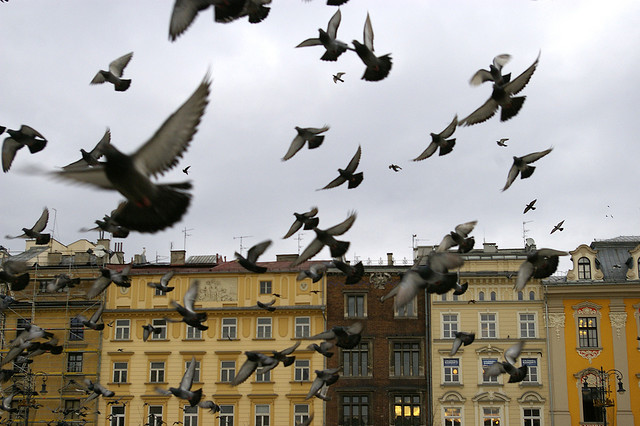
Pigeons seem like particularly stupid birds. They alternate between frantic head bobbing and blank gazes, which are often interrupted with a lazy flutter of their oil-sheen plumage to avoid bone-crushing foot falls. But these flying rats may just be putting on a good show. Research published Wednesday shows that urban dwelling birds tend to have substantially larger brains than their country-bumpkin cousins.
A study of 82 passerine species in and around twelve continental European cities discovered that birds which are able to breed in the city center tend to have larger brains.¹ Pigeons occupy similar ecological niches to some of the surveyed species, despite the fact that they are not passerines and were not included in the study. So while the results don’t address the pigeon-stupidity issue directly, they do give us a clue about the potential intelligence lurking beneath that vacant exterior. In the study, researchers used the ratio of brain size-to-body mass as a proxy for intelligence.
The brain-body ratio, also known as Cuvier’s fraction, has been widely used as proxy for intelligence. It makes sense in many ways: the larger the proportion of the body devoted to intelligence, the better the chances the species will actually be intelligent. For example, look at porpoises and ostriches—both weigh approximately the same, but the cetacean is clearly smarter. In birds, such intelligence can aid adaptation to the “novel and harsh” urban environment, the researchers pointed out. The brain-body ratio isn’t perfect—there are small monkeys that have a larger ratio than humans, for instance—but it’s the best the researchers had given the dearth of bird brain studies.
Though this isn’t the first study to link avian intelligence to successful colonization, it is the first evidence of the trend applying in cities. That’s good news for the smart cookies, but could portend tough times for birds with smaller brain-body ratios in rapidly urbanizing areas.
- Here’s a sample of families that can successfully breed in Continental cities: Chickadees and tits (Paridae), nuthatches (Sittidae), kinglets or crests (Regulidae), starlings (Sturnidae), accentors (Prunellidae), and wrens (Troglodytidae). (There are many more species listed in the paper that have successfully adapted to the city—these are just the families where all of the surveyed species could breed in the city.)↩
Source:
Alexei A. Maklakov, Simone Immler, Alejandro Gonzalez-Voyer, Johanna Rönn, & Niclas Kolm (2011). Brains and the city: big-brained passerine birds succeed in urban environments Biology Letters : 10.1098/rsbl.2011.0341
Photo by Mr Thomas Piskortz.
Related post: